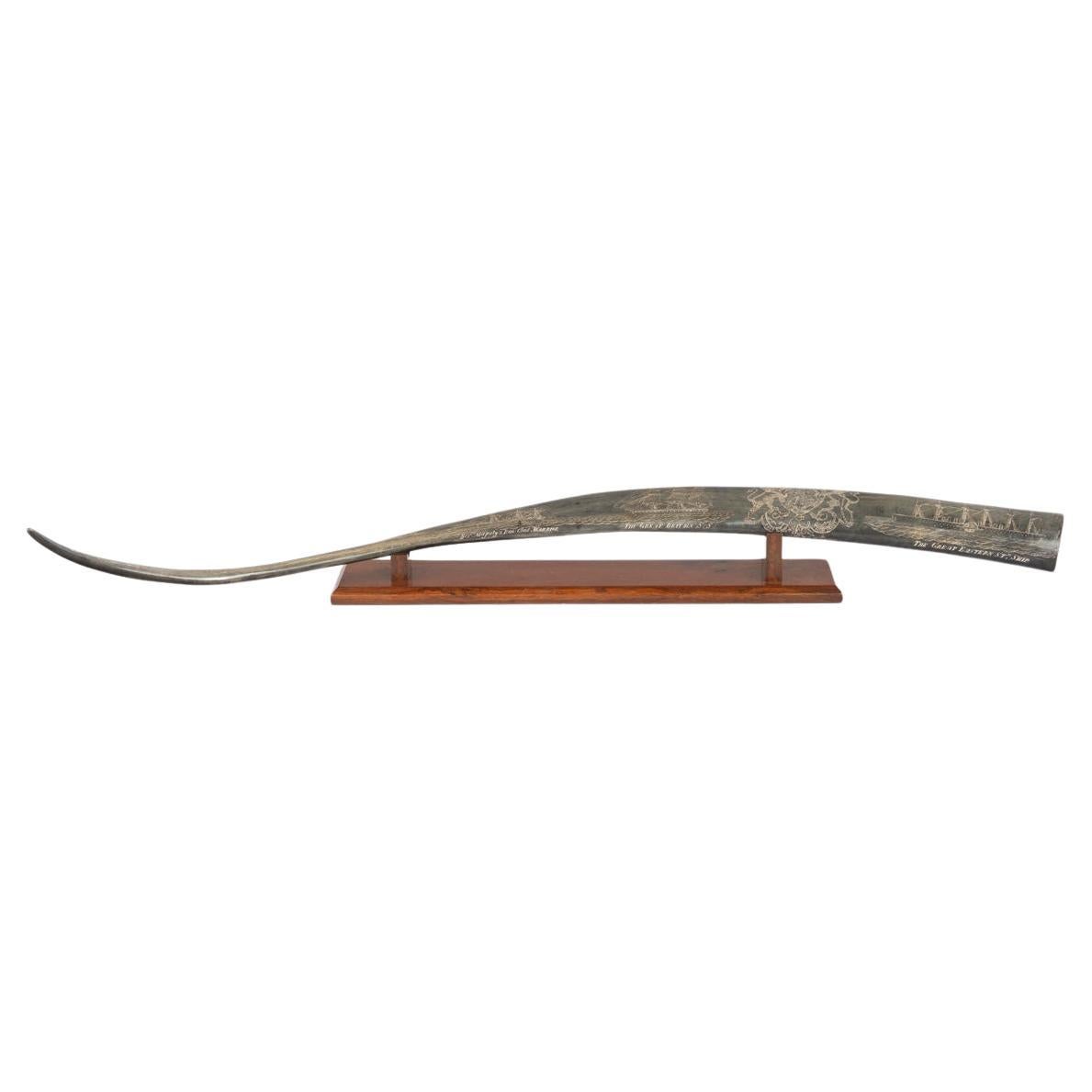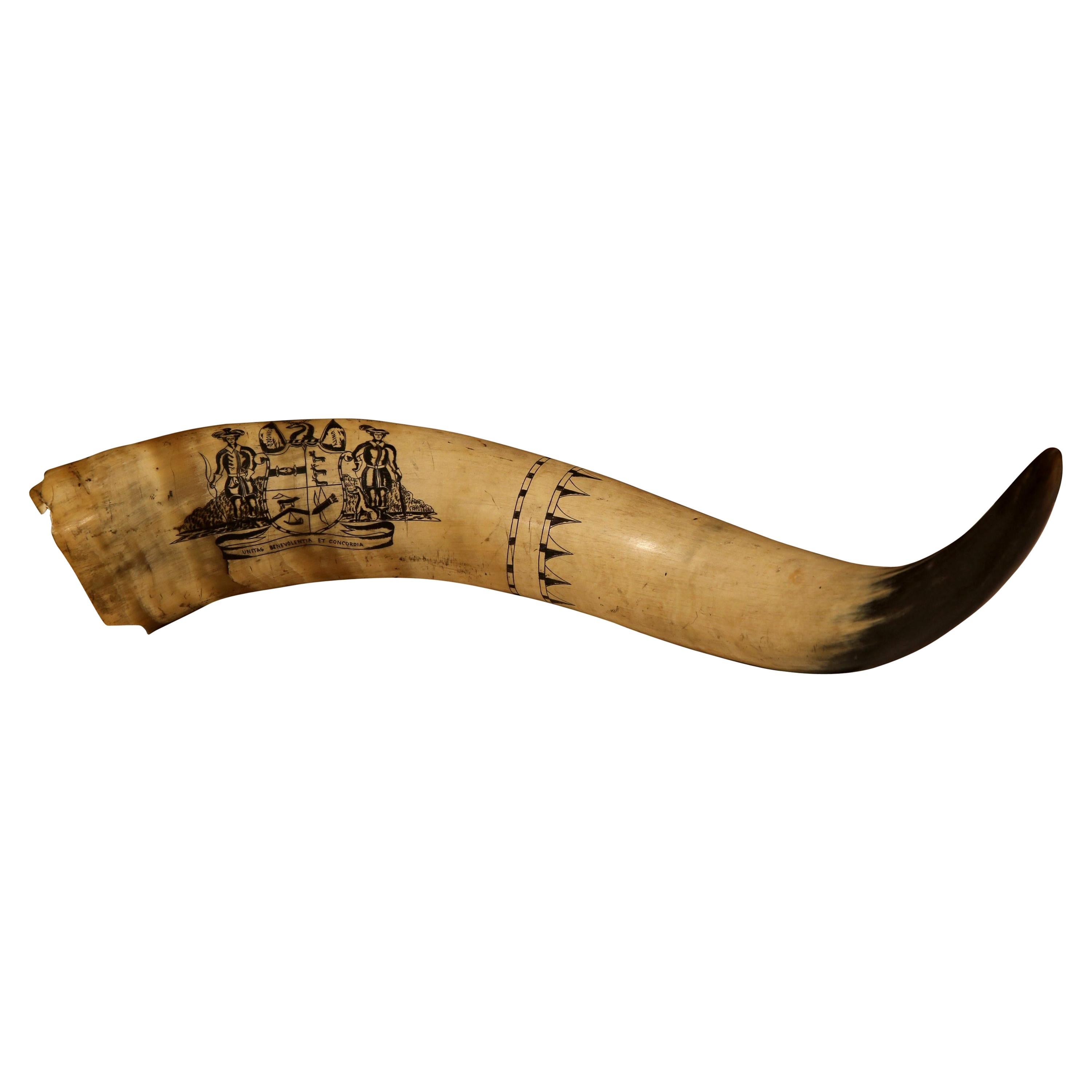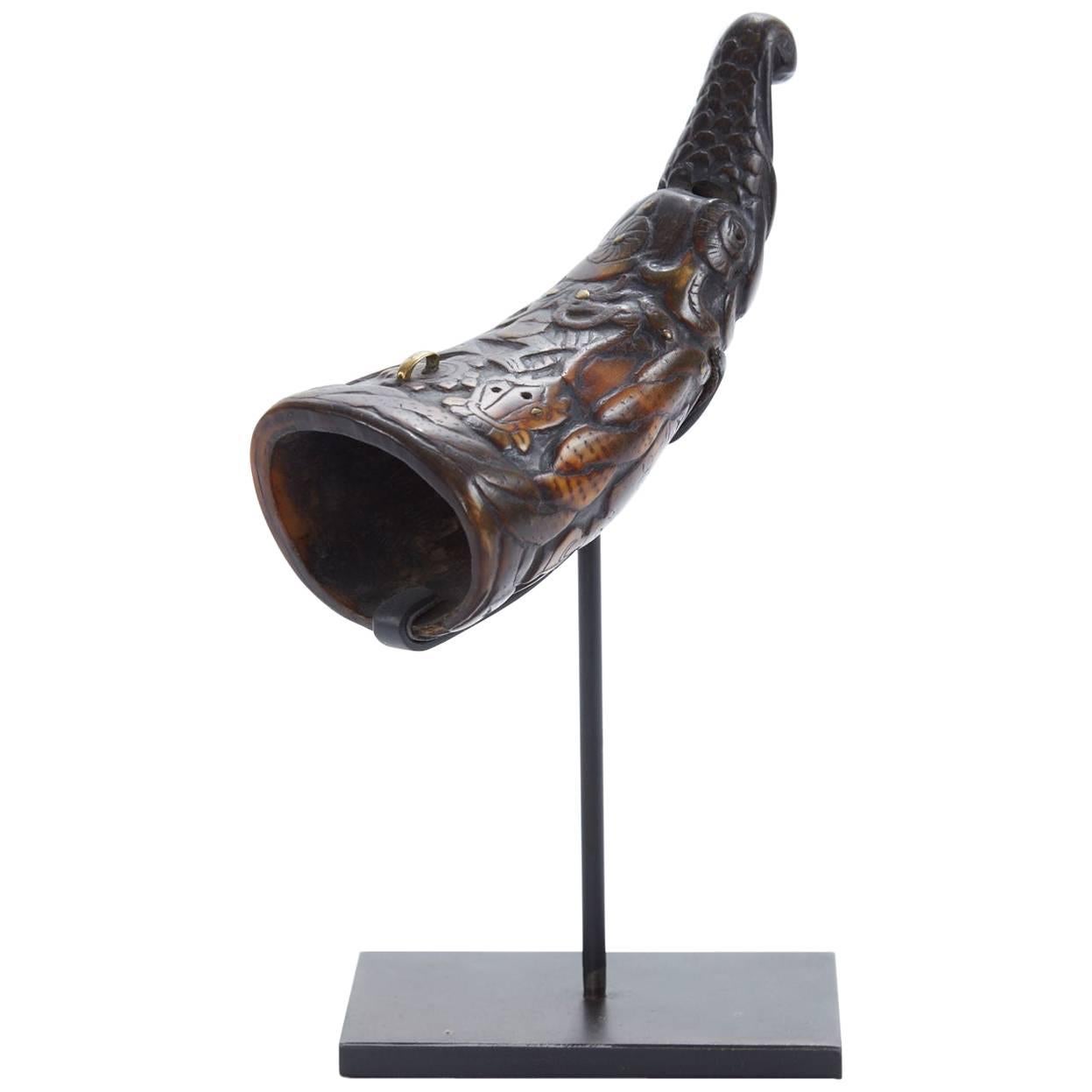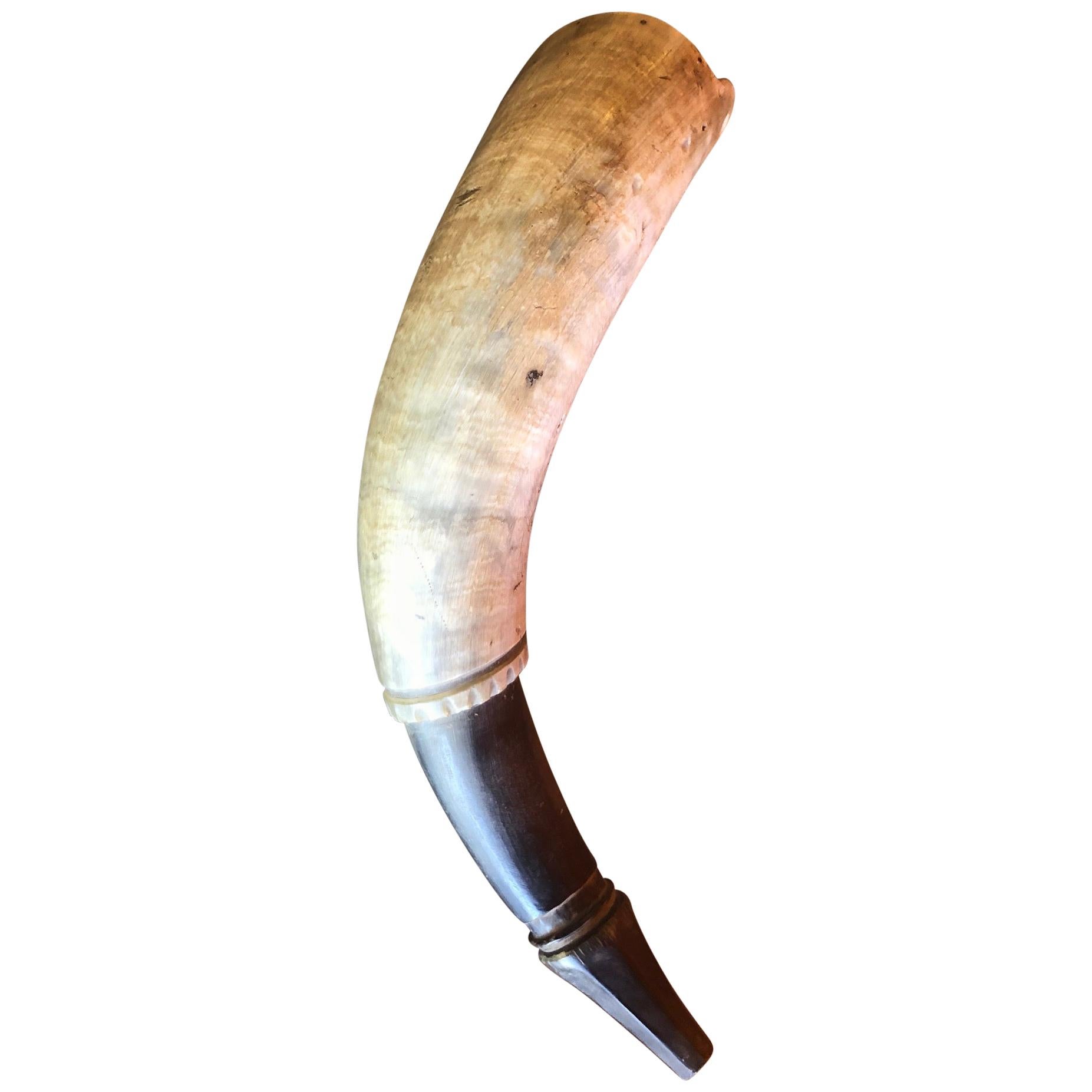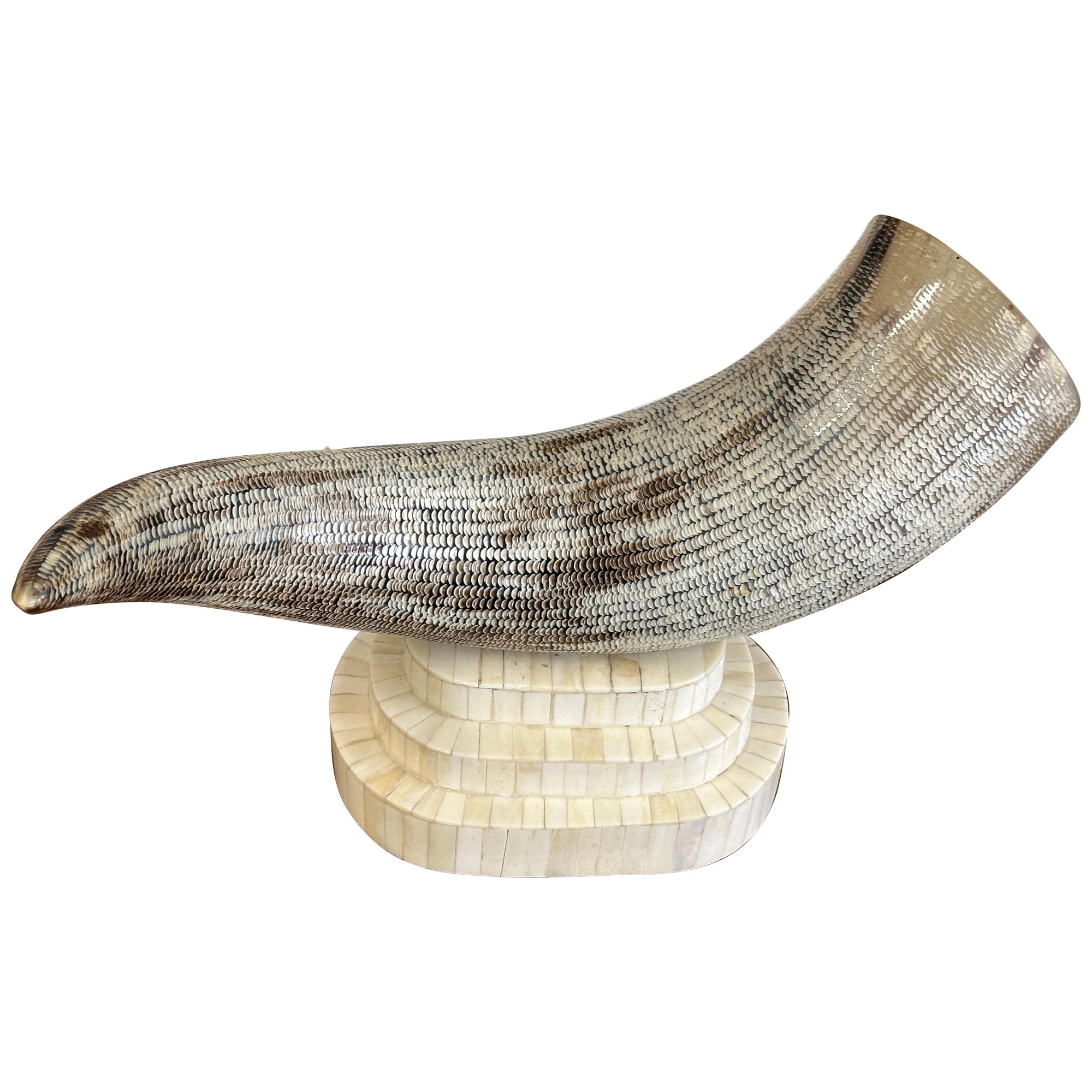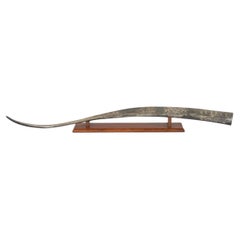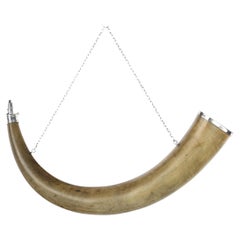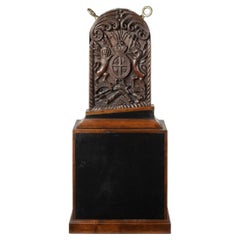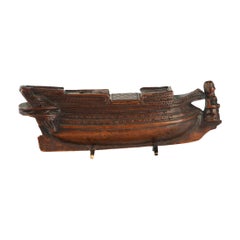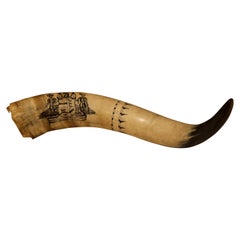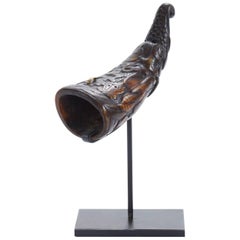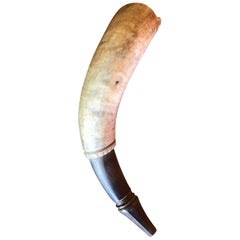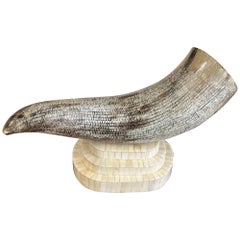Articoli simili a A rare scrimshaw decorated horn attributed to C.H. Wood
Vuoi altre immagini o video?
Richiedi altre immagini o video al venditore
1 di 19
A rare scrimshaw decorated horn attributed to C.H. Wood
10.218,36 €
Informazioni sull’articolo
A rare scrimshaw decorated horn attributed to C.H. Wood. Each curled horn is ornately carved with important motif’s relating to the Battle of Trafalgar and iconic battleships. Our two horns are fascinating examples of the work of this extremely talented man and are truly museum quality pieces in themselves.
A Rare Scrimshaw Decorated Horn
The poem can be found below;
Lines
Britannia’s favourite and his sovereign’s pride
He rul’d despotic Lord of ocean’s tide
Each coast remember’d for some deed of fame
Was made illustrious by Great Nelson’s name
Denmark, Iberia, Eygpt’s tropical shore
Heard the dread’ thunder of his cannon roar
While laurels won from ev’ry hostile fleet
He laid in triumph at his Monarch’s feet
And history ever shall record the day
Bright with his glory in Trafalgar’s Bay
Thro’ every chine he’d sought but sought in vain
The still retreating fleets of France and Spain
When found at last he crush’d them on the flood
And seal’d the awful conquest with his blood
Signed on reverse.
Footnote:
Little is known about the mysterious C. H. Wood but it has now been established by good reasonable doubt that he was born Charles H. Wood and, according to new sources we have discovered, he was a Liverpool man and at one point worked for a Mr Winsland, builder in London. He was English by birth but enjoyed a truly international career, seemingly working in both America and Australia and exhibiting his exceptional productions on board ships and at ports. In her article Advance Australia: C. H. Wood, Embellisher-of-Sea-Shells, Ox-Horn and Whale-Ivory, published in Australiana, November 1992, Susan M. Frank describes Wood’s career as an engraver beginning as follows:
‘In June 1845, on the occasion of the maiden transatlantic voyage of Isambard Kingdom Brunel’s revolutionary steamship Great Britain, an obscure English engraver named C. H. Wood produced a elaborate presentation piece expertly incised in the manner of whalemen’s scrimshaw on the voluminous inner surface of a large seashell. Featuring portraits of the Great Britain and Great Western (another of Brunel’s ocean-going leviathans, launched in 1837), the shell was dedicated to Queen Victoria and consort Prince Albert, to whom Wood presented it as a gift. Whether or not this presentation was ever actually acknowledged at Windsor Castle, it marks the debut of Wood’s progression of royal patronage into a thriving scrimshaw business. His entire subsequent career and reputation in the English press were inextricably linked to the fame and ill-starred fortunes of Brunel’s controversial ships.’
Later in the article, Frank refers to Wood’s engraved and signed nautilus and conch pieces:
‘In the same period when he was making shellwork souvenirs Wood was evidently also engaged in engraving bovine horn, but none have survived. He and his tenuous royal connections continued. Most of it was with the English Royal Family and most of it was conducted from 1845 until 1857. Each new development in the English Royal Family was signalled by engraved shells, complete with commemorative inscriptions and poems, one signed by the engraver C. H. Wood, horn embellisher to HHRH Fred and HHRH Prince Consort (sic). It seems unlikely that he ever ventured further than the Yankee whale fishery and on this or some other occasion may have visited Australia.’
The two engraved horns now on collection, one signed and one not, add further to this small corpus of surviving pieces. Wood is believed to have exhibited his carved shells at the Great Exhibition in 1851 and the International Exhibition of 1862. A nautilus shell engraved with a view of the Great Eastern steamship is in the collection of the Yale Center for British Art.
another is in the SS Great Britain Museum
and a conch shell engraved to commemorate the death of Prince Albert is in the British Museum
Susan M. Frank also contributed an article on Wood to the Dictionary of Scrimshaw Artists, published in 1991.
Research in the British Newspaper Archive has allowed us to shed further light on Wood’s career and work. The first reference we discovered is in Carlisle Patriot, dated the 24th of January 1845. Wood is described as
‘an artisan in the employ of Mr Winsland, builder, London’ and the article relates the story of his presenting a shell to the King and Queen.
On the 25th of April 1849, Wood found himself in front of a judge having been accused of stealing two pairs of children’s shoes when drunk. The case was dismissed but not before an account of Wood’s talent was given to the court. An account in the London Evening Standard, on the 26th of April reveals that Wood’s engraved shell, mentioned in Frank’s article, was indeed accepted by the Royal family and that ‘a sum in gold was presented to him in return by his Sovereign’. He later received a package from the Queen including a framed proof engraving of the coronation by Hayter. Another article on this same court case was published in John Bull on the 30th of April 1849. There is further material of interest in this piece as it describes the fact that Wood made his way to sell two of his engraved shells to a lady who had agreed to purchase them before he got drunk. Additionally, the article states that Wood’s lawyer told the court that Wood had
‘gained great celebrity for his power of engraving on shells. Although a painter, he had taught himself to engrave in the most beautiful manner on shells’.
This is the only reference located so far that refers to Wood’s profession and, as such, is extremely interesting.
Perhaps more fascinating still is an article published in the Liverpool Daily Post on the 26th of October 1861. It reads:
‘Mr C. H. Wood, the celebrated shell engraver connected with the Great Eastern, in accordance of his usual custom of bestowing an engraved shell on the mayor of whatever port the ship may enter, intends in a day or two to present one of his wonderful specimens to our worthy chief magistrate’
These newspaper accounts do suggest that the reason that Wood’s pieces survive is that they were almost always treasured presentation pieces and not tourist souvenirs as has been thought to be the case until now. A further newspaper account, published long after Wood’s death in the Huddersfield and Holmfirth Examiner on the 21st of November 1964 sheds further light on Wood and his activities. The article illustrates two career nautilus shells which had passed down through the family of a Mrs Crowther to her granddaughter Mrs Byram.
‘Apparently the Crowthers became very friendly with the captain on their journey (aboard the Great Eastern) and he gave them the shells to remind them of the Great Eastern.
Obviously the captain C. H. Wood (was like many sailors) good with his hands, and the shells are beautifully inscribed.’
If the article is to be believed then it would seem that Mr Wood was captain of the Great Eastern. However a list of the captains on the ship does not include Wood’s name so this seems likely to have been a mistake made by the journalist at the time.
An article published in the Ulverston Mirror and Furness Reflector on the 6th of September 1862 quotes from another article published in the “Preston paper”. It records Wood presenting an engraved shell to the Mayor of Preston that same year as well as a sculptured bullova egg which he gave to the Mayoress. There are three details in this article which are of particular interest. The first is that Wood is described as ‘Mr C. H. Wood of Liverpool, sculptor and engraver on shells’, seemingly establishing a little more about the life of this fascinating man. Secondly the article ends by mentioning that Wood whilst connected with the Great Eastern made similar presents to the mayors of London, Southampton, Cork, Liverpool &c., suggesting that Wood was no longer connected to the ship at this stage. Finally, the description of the shell presented to the Mayor of Preston includes ‘a beautifully engraved figure, representing Peace, seated on the prow of a vessel, and pointing to the victory achieved by the great English hero Nelson’. This demonstrates that Wood had used Nelson as a subject and strengthens the attribution of our unsigned piece to the master.
In addition to the range of shells engraved by Wood discussed above, there is also one other carved horn which is attributed to Wood and is known as The Horn of Australia due to its iconography relating to that country. It is in the collection of the Kendall Whaling Museum in the US but is now on loan to the Australian National Maritime Museum, Sydney.
- Dimensioni:Altezza: 10,8 cm (4,25 in)Larghezza: 8,89 cm (3,5 in)Profondità: 71,12 cm (28 in)
- Materiali e tecniche:
- Luogo di origine:
- Periodo:
- Data di produzione:1830–1870
- Condizioni:Usura compatibile con l’età e l’utilizzo. Good.
- Località del venditore:Lymington, GB
- Numero di riferimento:1stDibs: LU973047068952
Informazioni sul venditore
5,0
Venditore riconosciuto
Questi venditori prestigiosi sono leader del settore e rappresentano il massimo in termini di qualità e design.
Fondazione nel 1982
Venditore 1stDibs dal 2013
137 vendite su 1stDibs
Tempo di risposta standard: 1 ora
Associazioni
LAPADA - The Association of Arts & Antiques Dealers
- SpedizioneRecupero del preventivo…Spedizione da: Lymington, Regno Unito
- Politica di reso
Alcune parti di questa pagina sono state tradotte automaticamente. 1stDibs non può garantire che le traduzioni siano corrette. L’inglese è la lingua predefinita del sito.
Garanzia di autenticità
Nell’improbabile caso in cui si verifichi un problema con l’autenticità di un articolo, contattaci entro un anno per ottenere un rimborso completo. DettagliGaranzia di rimborso
Se il tuo articolo non corrisponde alla descrizione, è danneggiato durante il trasporto o non arriva, contattaci entro 7 giorni per un rimborso completo. DettagliAnnullamento entro 24 ore
Hai un periodo di tolleranza di 24 ore per annullare il tuo acquisto, senza necessità di fornire spiegazioni.Venditori professionali selezionati
I nostri venditori di livello internazionale devono aderire a rigorosi standard di servizio e qualità, garantendo l’integrità delle inserzioni.Garanzia miglior prezzo
Se scopri che un venditore ha pubblicato altrove lo stesso articolo a un prezzo più basso, applicheremo lo stesso prezzo.Consegna globale affidabile
La nostra rete di vettori leader del settore offre opzioni di spedizione specializzate in tutto il mondo, inclusa la consegna personalizzata.Altro da questo venditore
Mostra tuttoRaro corno decorato Scrimshaw
Un raro corno decorato con scrimshaw, inciso su un lato con le armi reali controfirmate e i profili delle navi intitolate Great Eastern, Great Britain, H. M. S. Warrior.
Categoria
Di antiquariato/d’epoca, Anni 1860, Inglese, Oggetti nautici
Materiali
Corno
11.980 €
Un corno da cipria in argento di Giorgio III molto fine e storicamente significativo
Questo corno da polvere fine ha una montatura in argento realizzata dagli argentieri Thomas Phipps Robinson & Edward Robinson, con marchio di Londra, 1803. Il caricatore del corno ha...
Categoria
Di antiquariato/d’epoca, Inizio XIX secolo, Inglese, Giorgio III, Oggett...
Materiali
Argento
Royal Naval Ship's Elm Companionway Board (tavola di navigazione della nave)
Tavoletta di compagnia in olmo della Royal Naval, di forma rettangolare con piano arcuato e due robusti anelli in ottone, ingenuamente intagliata con uno stemma coronato affiancato d...
Categoria
Di antiquariato/d’epoca, Anni 1860, Inglese, Oggetti nautici
Materiali
Olmo
Una tabacchiera da battaglia per prigionieri di guerra in legno di bosso intagliato
Una tabacchiera da battaglia per prigionieri di guerra in legno di bosso intagliato. Questa piccola tabacchiera è scolpita nella forma di una nave di linea da 112 cannoni con un cass...
Categoria
Di antiquariato/d’epoca, XIX secolo, Inglese, Portatabacco
Materiali
Bosso
Grande barra d'olmo proveniente dal peschereccio Brixam 'Provident'
Una grande barra in olmo con timone in bronzo e terminale tornito proveniente dal peschereccio di Brixham 'Provident', 1924
Dettagli sulla previdenza:
Costruttore: J Sanders,...
Categoria
Vintage, Anni 1920, Inglese, Attrezzatura sportiva e memorabilia
Materiali
Olmo
Cannone del Royal Yacht Club di Southampton
Questa coppia di cannoni da segnalazione in bronzo a tre stadi, di epoca vittoriana, è montata su carrelli in olmo con accessori in bronzo.
Ogni canna affusolata da 39 pollici ha ...
Categoria
Di antiquariato/d’epoca, Anni 1840, Inglese, Memorabilia storici
Materiali
Bronzo
Ti potrebbe interessare anche
Corno di manzo Scrimshaw inglese del XIX secolo con incisione in nero della cresta dell'armoriale
Decora l'ufficio di un uomo con questo pregiato e antico corno di manzo scrimshaw. Trovato in Inghilterra, intorno al 1870, il corno sfoggia un impressionante lavoro di incisione e n...
Categoria
Di antiquariato/d’epoca, Fine XIX secolo, Inglese, Altri accessori da sc...
Materiali
Corno
Rituale intagliato a mano della fine del XIX secolo "Thun Rwa Horn con intarsi in oro
Il corno "Thun Rwa", intagliato a mano alla fine del XIX secolo, era usato comunemente dai Ngakpa (lama laici) del Tibet. Utilizzato come strumento di guarigione con polveri medicina...
Categoria
Di antiquariato/d’epoca, Fine XIX secolo, Burkinabé, Soprammobili
Materiali
Oro
Corno da polvere antico del XIX secolo con scrimshaw
Raro corno da polvere antico del XIX secolo con scrimshaw, circa 1872. Il corno reca l'iscrizione "Charles Lee" in cartiglio sul lato del corno e il tappo in legno è intagliato con l...
Categoria
Di antiquariato/d’epoca, Metà XIX secolo, Americano, Arte popolare, Scul...
Materiali
Metallo
1049 € Prezzo promozionale
20% in meno
Horn intagliato e inciso montato su una base di osso tessellato
Interessante scultura decorativa, questo corno inciso è montato su una base d'osso tessellata. È molto simile allo stile di Maitland Smith o di un'azienda simile. Il corno è probabil...
Categoria
XX secolo, Sconosciuto, Esemplari naturali
Materiali
Osso, Corno
Horn decorativo con chiusura in ottone e punta in ottone per conservare, bere, 420
Un bellissimo corno - tipicamente utilizzato come tazza per bere in campeggio o per conservare qualsiasi cosa, dalla polvere da sparo al tabacco - oggi, con l'aggiunta di un bellissi...
Categoria
XX secolo, Inglese, Rustico, Arte tribale
Materiali
Ottone
Una polveriera. Corno inciso, corda, sughero. Spagna, XIX secolo.
Una polveriera. Corno inciso, corda, sughero. Spagna, XIX secolo.
Un contenitore per conservare la polvere da sparo ricavato da un corno di mucca e decorato all'esterno con una seri...
Categoria
Di antiquariato/d’epoca, XIX secolo, Spagnolo, Neoclassico, Attrezzatura...
Materiali
Metallo, Altro
